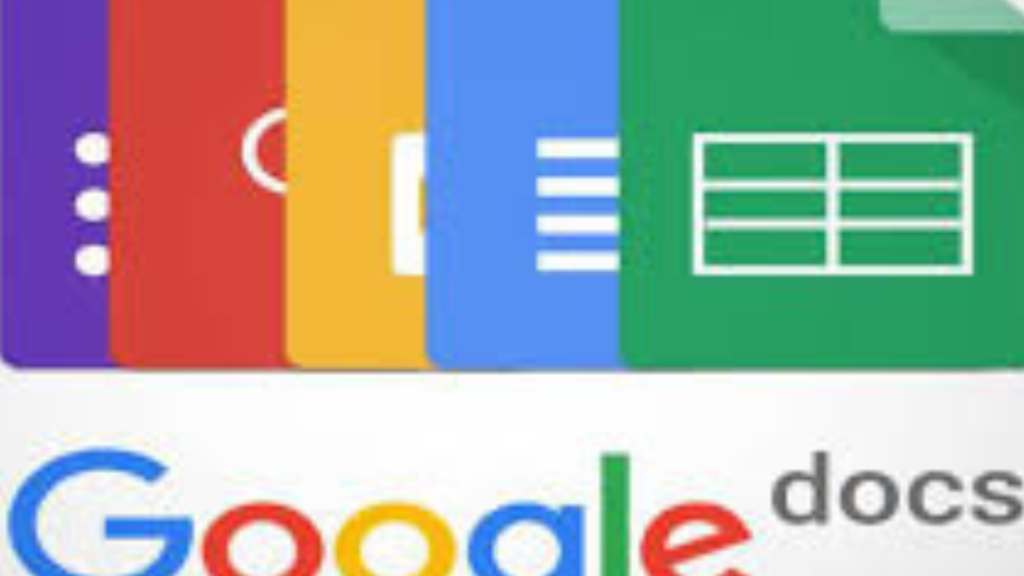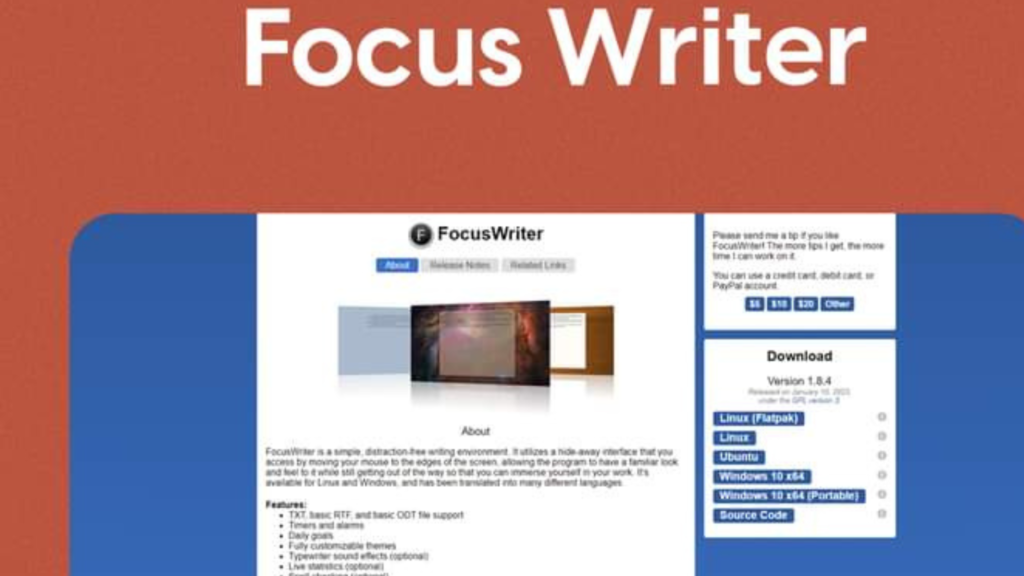For writers of all skill levels, free writing software has emerged as a vital resource because of its array of features that support increased productivity, creativity, and organization without requiring expensive purchases.
These resources can improve the effectiveness and bliss of writing, regardless of whether you’re a professional writer, a student, or someone who writes for fun.
In this article, I’ll be exploring the amazing features of these free writing software, the numerous kinds that are out there, and how they can be used for a range of writing tasks, from managing freelancing assignments to penning novels. With these resources at your disposal, writing becomes more accessible and you can concentrate on what really counts—bringing your thoughts to life on paper.
Let’s dive in…
1.1 What is Writing Software?

When we talk about writing software, we’re talking about digital tools and programs that help authors create, edit, organize, and manage written content. Many capabilities, including drafting, formatting, grammar checking, brainstorming, and project management, are available in these systems, each catered to a distinct set of writing requirements.
On the other hand free writing software are tools you can access online without payment or subscription fee.
Writing software can vary from simple word processors such as Google Docs and Microsoft Word to specialist programs for content management, blogging, screenwriting, and novels. Certain writing software comes with features like formats or genre-specific templates, cloud storage, collaborative options, and writing modes that prevent distractions.
Writing software makes it easier to concentrate on content production while managing the technical and organizational parts of writing, whether you’re a student, blogger, journalist, or author. With a variety of solutions accessible, writers can select writing software that best suits their demands and budget, whether they are free or paid.
1.2. The Benefits of Using Free Writing Software
There are several benefits to using free writing software, which makes it a desirable choice for writers at every level of experience. The following are some main advantages:
Cost-Effective: The cost barrier to getting high-quality writing tools is removed with free writing software. Many of the same capabilities as commercial software are available in free versions, making them an excellent choice for those just starting out or trying to cut costs.
Accessibility: Majority of free writing software can be accessed on a variety of platforms, such as computers, laptops, tablets, and smartphones, by downloading it as an application or by browsing its website. Because one can access them freely, writers can work with them whenever and from anyplace.
Feature-Rich: Several free writing software offer an extensive feature set to meet various writing requirements from basic word processing and formatting to sophisticated features like grammar checks, style recommendations, and project management tools. These applications frequently outperform their commercial counterparts.
Distraction-Free Writing: Distraction-free modes are a feature of many free writing software, which aids concentration by offering authors a neat, uncluttered interface. Those who have trouble focusing or avoiding distractions may find this to be especially helpful.
Collaboration and Sharing: There are many free writing software with features that make sharing and collaboration simple. The ability for several users to collaborate on a single document at once makes tools like Google Docs perfect for group projects or gathering feedback from others.
Automatic Saving and Cloud Storage: The likelihood of losing work owing to technological problems is decreased by the fact that free writing software frequently include cloud storage and automated saving features. You can access your work from different devices and have peace of mind knowing that everything is safely backed up.
Community and Support: Online forums, tutorials, and resources are available for many free writing software, which are also backed by vibrant user communities. For novice users who require assistance or wish to fully utilize the product, this can be immensely beneficial.
Experimentation Without Commitment: It’s possible to try out many tools and features of free writing software before making a purchase. When determining which writing style and workflow best suit your needs before making a premium software purchase, this is especially helpful.
Compatibility and Integration: A lot of free writing software are made to work well with other apps and websites, including social media, email, and content management systems (CMS). The posting and sharing of content can be made more efficient by this compatibility.
Continuous Updates: Updates and enhancements are frequently made to free writing software as a result of user input. Assuring that the program stays up to date and functional, developers constantly add new features, correct issues, and improve the overall user experience.
1.3. Overview of Popular Free Writing Software

Popular free writing software are readily available, each with special features and functionalities to meet various writing requirements. An overview of some of the most popular free writing tools is provided below:
1. Google Docs
Google Docs is an online word processor that works in the cloud that lets users create, edit, and share documents. Because it allows for real-time communication, it’s perfect for group tasks and getting input from others.
Key Features:
- Real-time collaboration with multiple users
- Automatic saving and cloud storage
- Integration with other Google Workspace tools (Sheets, Slides, etc.)
- A wide range of formatting options
- Offline access with the Google Docs offline extension
2. Scrivener (Free Trial Version)
For creating lengthy pieces like novels, research papers, and screenplays, Scrivener is an effective writing tool. There is a free 30-day trial available for Scrivener, but the full software requires payment.
Key Features:
- Corkboard and outlining tools for organizing ideas
- Distraction-free writing mode
- Project management features for large writing projects
- Export to multiple formats (PDF, ePub, Word, etc.)
- Research organization with a built-in notes and reference section
A free and open-source word processor included in the LibreOffice suite is called LibreOffice Writer. It is appropriate for a range of writing styles and has a feature set that is comparable to Microsoft Word.
Key Features:
- Full suite of formatting and styling tools
- Compatibility with Microsoft Word files (.doc and .docx)
- Export options for PDFs and other formats
- Built-in templates for different types of documents
- Spell check, grammar check, and thesaurus tools
4. FocusWriter

FocusWriter is a simple, distraction-free writing software made for authors who want to maintain concentrate. It has a straightforward user interface that emphasizes uninterrupted writing.
Key Features:
- Full-screen, distraction-free writing environment
- Customizable themes and backgrounds
- Daily goal tracking for word count and writing time
- Auto-save and backup features
- Cross-platform support (Windows, macOS, Linux)
5. Evernote (Basic Version)
Evernote is an app that helps you take notes and organize your ideas, research, and drafts. It is also a useful writing tool. With adequate capabilities for most writers, the basic edition is available for free.
Key Features:
- Organize notes, ideas, and research in notebooks
- Web clipping tool for saving online resources
- Cross-device synchronization
- Basic text formatting and note-taking capabilities
- Integration with other apps (Google Drive, Slack, etc.)
6. Zoho Writer
Included in the Zoho Office Suite is the online word processor Zoho Writer. It has a simple interface and a number of capabilities that may be used by teams as well as lone writers.
Key Features:
- Real-time collaboration with other users
- Document sharing and permissions management
- Offline mode for working without an internet connection
- Advanced formatting and styling options
- Integration with Zoho’s other tools and third-party apps
Reedsy Book Editor a free online application was created especially for writers who want to prepare and export their manuscripts into book-ready formats.
Key Features:
- Simple, distraction-free writing interface
- Professional typesetting and formatting options
- Export to ePub and print-ready PDF formats
- Collaboration with editors and co-authors
- Integrated project management tools for tracking progress
8. Notion
Notion is a single workspace that integrates writing, task management, and note-taking features. Writers love it because it allows them to arrange ideas and projects in a highly customizable setting.
Key Features:
- Customizable templates and pages
- Integration of notes, tasks, and databases in one place
- Collaboration features with shared workspaces
- Cross-platform availability with synchronization
- Support for multimedia and embedded content
Hemingway Editor is an online application designed to help you write more succinctly and clearly. It helps writers make their writing more readable by emphasizing adverbs, complex phrases, and passive voice.
Key Features:
- Readability analysis and grading
- Highlighting of complex sentences and passive voice
- Word count and reading time estimates
- Direct publishing to Medium and WordPress
- Simple, distraction-free interface
10. yWrite

Novelists can use the free writing software yWriter. It facilitates the division of stories into chapters and scenes, which makes handling complicated narratives simpler for writers.
Key Features:
- Scene and chapter management tools
- Character and plot development features
- Automatic saving and backup
- Storyboard view for visualizing your novel
- Cross-platform availability (Windows, macOS, Linux)
2. Key Features to Look for in Free Writing Software
The following are important characteristics to consider when selecting free writing software:
1. User-Friendly Interface:
Any free writing software you desire to use should have an intuitive and simple-to-use interface, allowing you to concentrate on writing without being distracted by complex menus or features.
2. Word Processing Tools:
To assist you produce professional work, look for software that has basic word processing capabilities like spell check, grammar check, and formatting options (bold, italics, headings).
3. Cloud Storage and Syncing:
If you’re a writer who is constantly on the road, the capacity to store your work on the cloud and retrieve it from any device is essential. No matter where you write, software with seamless syncing guarantees that your work is always current and ready for retrieval.
4. Distraction-Free Writing Mode:
You can’t get any writing done if your screen is stuff with distractive notifications. A free writing software with a full-screen, distraction-free mode is what you should go for. This kind of software can help you focus on your writing by eliminating on-screen clutter and notifications.
5. Outline and Organization Tools:
Look out for features like outline, note taking and the ability to organize your work into sections or chapters when making a choice of free writing software especially if your tasks involves writings like books or articles. Features like these are valuable, especially for longer projects like books or articles.
6. Collaboration Features:
If you frequently collaborate with editors or other authors’ software with real-time collaboration capabilities, such as version history, tracking changes, and commenting, is recommended.
7. Export and Compatibility:
Ensure the software can export your work in multiple formats (e.g., DOCX, PDF, TXT) and is compatible with other popular writing tools.
8. Auto-Save and Backup:
Can the free writing app auto-save your works, restore to previous versions or back it up ensuring you never lose them? If yes, then you you’re free to make use of it.
9. Customization Options:
Is the free writing software customizable? Writing can be more comfortable and fun when you can personalize your writing environment, make use of layout, themes, and fonts that suits your taste.
10. Support and Community:
How supportive is the community? A strong user community, tutorials, and customer support can be incredibly helpful, especially when you’re learning how to use new software so take note.
11. Mobile and Offline Access:
If you enjoy writing while you’re on the go, search for software that allows you to work without an internet connection and has a strong mobile app.
12. Templates and Writing Prompts:
To help you get started or organize your work, some writing software offers templates (for novels, screenplays, etc.) or writing prompts so I implore you to look out for these key features.
3. Top Free Writing Software Options Reviewed
Having the appropriate writing resources at your disposal can be really beneficial when starting any writing endeavor. Choosing the best writing software is crucial, whether you’re writing a novel, creating blog pieces, or taking notes for your next big idea.
Even if there are many paid solutions accessible, not everyone has the money to purchase expensive gear. Thankfully, there are a number of free writing software solutions available with a feature-rich feature set to suit the demands of writers like you. In order to assist you in selecting the greatest free writing software for your creative process, we’ll examine three of the best solutions out there and analyze their advantages and disadvantages:
3.1. Google Docs
The accessibility, functionality, and real-time collaboration features of Google Docs make it a popular choice among writers, students, and professionals. It is perfect for group projects and collaborative writing because it is a cloud-based word processor that enables several users to work on a document at once from any location.
Google Docs’ ability to integrate with other Google services—like Google Keep for efficient note-taking and Google Drive for simple file storage and sharing—is one of its best features. In order to ensure compatibility with other tools you might be using, the software also supports a wide range of file types, such as DOCX, PDF, and plain text.
Google Docs offers a distraction-free mode and a range of templates to get started on various document formats, from research papers to resumes, for individuals who appreciate freedom. It also comes with everything you need to create polished content, like voice typing, grammatical suggestions, and built-in spell check.
The software does have certain restrictions, though. It provides basic word processing functions, but its additional features—such as the ability to update track changes or use more complex formatting options—might not be as extensive as those offered by Microsoft Word or other commercial competitors.
Google Docs keeps documents on Google’s servers, which may not be the best option for extremely sensitive content, so if you are concerned about privacy you have to take this fact into consideration.
3.2. LibreOffice Writer
An excellent substitute for expensive programs like Microsoft Word is LibreOffice Writer, an open-source word processor that is available for free and has a large feature set. Writer, a component of the LibreOffice suite, offers strong document creation features, such as a broad range of file compatibility, styles, templates, and advanced formatting options.
Unlike cloud-based applications, Writer’s offline capabilities lets you operate without an internet connection. This is one of its best advantages. It also makes it simple to open and save documents in formats compatible with other word processors by supporting a number of file formats, such as DOCX, ODT, and PDF.
Writer has features like comments, track changes, and sophisticated page layout options for users that need to have complete control over their projects. With its capacity to manage big documents effectively, it works well for everything from straightforward notes to intricate reports.
Though LibreOffice Writer is an open-source program, it might not have as polished of an interface as certain commercial software, and its collaboration features aren’t as extensive as those of cloud-based equivalents like Google Docs. However, LibreOffice Writer is a great option for authors looking for a robust, free word processor that doesn’t require internet access.
3.3. Evernote:
Evernote is a flexible application that combines writing and note-taking features, making it perfect for authors who need to manage projects and arrange ideas centrally. Evernote, which is well-known for its robust organizing tools, lets you write, save, and organize notes, pictures, site clippings, and more on a single platform.
The primary advantage of Evernote is its cross-platform syncing capability, which makes your drafts and notes available on your computer, tablet, or smartphone. Additionally, it has strong search capabilities that let you locate particular notes or phrases fast, even in scanned documents.
Evernote’s user-friendly layout makes it simple for writers to compose blog posts, articles, or book chapters right within the program. It also offers basic word processing functions. Furthermore, handling longer writing assignments is facilitated by the ability to arrange notes into notebooks and tag them for simple retrieval.
While Evernote as a free writing software is great for note-taking and organization, it might not have all the sophisticated formatting and editing features of word processors like Google Docs or LibreOffice Writer. This app is useful for authors who value organization and require a roomy area for ideation, outlining, and writing.
4. Specialized Writing Software for Specific Needs
Writing is a complex field, and various tasks frequently call for different instruments to satisfy certain demands. Using software designed specifically for your writing work can significantly increase your productivity and attention, whether you’re managing extensive research, penning a novel, or screenwriting a screenplay. We’ll look at specific free writing software in this section that is made to meet particular writing needs, so you may select the right program for the job.
4.1. Fiction Writing: Tools that Aid Story Development
If you’re a fiction writer, there are several tools available to facilitate and improve your story building in. Here are a few of the best ones:
1. Plotting Tools

Scrivener: A strong writing tool that gives you the flexibility to arrange your work. Plot outlines, character profiles, and research management are all excellent uses for it.
Plottr: Plottr is a tool specifically made for planning that provides visual assistance such as scene cards and timelines to assist you in organizing the framework of your novel.
MindMeister: A mind-mapping tool can be quite helpful especially when you are scripting complex stories as it facilitates visual brainstorming and idea connecting.
2. Character Development Tools
Character Creator: You can create thorough character profiles with physical characteristics, psychological qualities, and backgrounds by using online tools such as this one.
Persona: This writing software assists you in delving deeply into the motivations, backstories, and story arcs of your characters to make sure they are interesting and well-rounded.
3. World-Building Tools
World Anvil: A comprehensive world-building tool that ensures consistency in your fictional universe by assisting you in creating and organizing everything from geography to culture.
Campfire: Another powerful tool for worldbuilding that lets you sketch out the cultures, histories, and magical systems of your world, among other things.
4. Writing and Editing Tools
Grammarly: helps you fix grammatical and stylistic errors in your writing.
ProWritingAid: provides a thorough critique of your work with an emphasis on readability, timing, overused terms, and other aspects.
Hemingway Editor: helps you write more succinctly and clearly by emphasizing passive voice and complex sentences.
5. Idea Generators
Story Engine: a deck of cards that facilitates the creation of character conflicts, tale twists, and story ideas. Excellent for getting past writer’s block.
Story Prompts by ServiceScape: provides a large selection of creative writing prompts to aid in the generation of fresh concepts or the exploration of various plot points.
6. Research Tools
Evernote: An application for taking notes that lets you store and arrange thoughts, references, and research materials all in one location.
Zotero: A tool to help you gather, arrange, and credit sources for research; especially helpful if you’re writing fiction that requires a lot of historical study.
7. Collaboration Tools
Google Docs: Enables real-time collaboration, enabling several users to collaborate on a document at once. Excellent for receiving input from beta readers or fellow authors.
Trello: A tool for project management that is used for task organization, progress tracking, and teamwork.
8. Time Management Tools
Pomodone: a Pomodoro timer that works in tandem with your task management software to keep you on task and productive.
FocusWriter: a peaceful writing space that eliminates outside interruptions and enables you to create daily objectives.

9. Visualization Tools
Scapple: a freeform text editor that facilitates the visual organization of ideas and helps you identify the connections between the many components of your tale.
Miro: A collaborative whiteboard application that facilitates unstructured ideation, illustration, and storyboard organization.
10. Publishing and Formatting Tools
Vellum: a tool made to easily format print books and eBooks, resulting in end results that seem professional.
Reedsy Book Editor: An online tool to assist you with the writing, editing, and formatting of your book in preparation for publication.
4.2. Academic Writing: Software for Research and Citations
Accuracy, structure, and completeness are required in academic writing, especially when it comes to research and citations. The following is a list of necessary software to help you with these tasks:
1. Reference Management Software
Zotero: a free, open-source tool that assists with gathering, arranging, and citing research sources. It creates citations and bibliographies in a variety of forms by integrating with word processors.
Mendeley: Another free reference organizer that lets you stay on top of research trends, collaborate with others online, and arrange your studies. For annotating documents, it also features an integrated PDF viewer.
EndNote: a more sophisticated reference management tool with many capabilities, such as full-text searching, a lot of citation types, and the capacity to arrange big research collections.
2. Citation Generators
BibTeX: utilized frequently with LaTeX to format references in scholarly works, especially those pertaining to the sciences. It works well for automating the citation process and organizing extensive bibliographies.
Citation Machine: An online tool that makes it simple and quick to construct appropriate citations in a variety of styles (APA, MLA, Chicago, etc.)
RefWorks: An online tool for managing citations that lets you make, manage, and arrange references as well as create bibliographies and citations for them.
3. Writing and Editing Tools
Scrivener: Despite being most known for fiction, Scrivener’s organizational capabilities make it helpful for academic writing as well. These features let you manage lengthy projects, such as theses and dissertations.
Overleaf: An online LaTeX editor is perfect for publishing and composing scientific papers. It has good integration with BibTeX for citation management and provides collaboration tools.
Grammarly: helps you write academic writing that is straightforward and error-free by assisting with grammar, punctuation, and style checks.
Hemingway Editor: makes your academic work easier to read and more succinct by helping you to streamline your writing.
4. Research Tools
Google Scholar: a freely available online search engine that indexes academic publications from a range of fields. It’s a trusted source for locating scholarly articles and monitoring citations.
PubMed: PubMed is an important resource for obtaining a wide range of scientific articles and papers, particularly for health and life sciences research.
JSTOR: a vast digital library spanning many fields that offers access to thousands of scholarly books, periodicals, and primary materials.
ResearchGate: a professional network for researchers where you may interact with others in your field, obtain articles, and pose questions.
5. Note-Taking Software
Evernote: An adaptable tool for taking notes that lets you cut web pages, arrange research notes, and sync information across devices.
OneNote: OneNote is a digital notebook that is a component of Microsoft Office. It may be used to arrange research notes, work together with colleagues, and connect with other Microsoft programs like Word and Excel.
Notion: an effective tool for task, research, and note organization. You can establish databases, link papers, and construct thorough research workflows due to Notion’s flexibility.
6. Plagiarism Checkers
Turnitin: Turnitin is a popular tool used in academic settings that detects plagiarism by matching your work to a sizable database of published works, books, and online articles.
Grammarly Premium: In addition to grammar checks, the premium edition has a plagiarism detection tool that compares your work to billions of online publications.
Quetext: A plagiarism checker that helps you make sure your work is unique and gives you thorough feedback on any possible plagiarism.
7. Project Management Tools
Trello: An adaptable project management application that assists you with academic writing projects’ task organization, deadline setting, and progress monitoring.
Asana: Another tool for managing projects that helps you construct intricate workflows, assign tasks, and cooperate with others to handle big academic projects.
Notion: Notion is great for note-taking, but it’s also a great tool for project management, as it lets you manage deadlines, work with team members, and arrange your research materials.
8. PDF Readers and Annotators
Adobe Acrobat Reader: a widely used program for reading and annotating PDF files. It could also be used for annotating academic papers, underlining key passages, and adding remarks.
Foxit Reader: a simple substitute for Adobe that provides comparable capabilities for annotating PDFs, such as commenting, note-taking, and highlighting.
Mendeley: Mendeley helps you easily organize and annotate your research papers with its annotation tools and reference management skills. It also comes with a PDF reader.
9. Mind Mapping Tools
MindMeister: aids with the visual organization of concepts and ideas, which is especially helpful when you’re first writing and organizing your academic work.
XMind: Another powerful mind mapping application that helps you arrange thoughts, generate outlines for your academic writing, and brainstorm.
4.3. Blogging and Content Writing: Platforms for Online Work
To reach your audience and show your work in a professional manner, selecting the appropriate platform is crucial when it comes to blogging and content writing. The top platforms for blogging and content authoring online are as follows:
1. WordPress (WordPress.com and WordPress.org)
WordPress.com offers an easy-to-use platform with a variety of paid and free themes, making it the ideal version for novices. You may add more features as your blog expands, and since it’s hosted, you don’t need to bother about technical setup.
2. Medium
For writers who wish to concentrate just on content, Medium is perfect. It provides an easy-to-use interface that doesn’t require any technical setup. Additionally, Medium gives you access to a preexisting audience, which facilitates getting your work discovered. Additionally, you can get paid based on reader engagement with Medium’s Partner Program.
3. LinkedIn
With LinkedIn’s publishing tool, you can create and distribute articles across your network. It’s a fantastic approach to build credibility in your sector, network with other professionals, and communicate with a professional audience.
4. Ghost
Ghost is a high-performance, minimalist platform made for publishing professionals. It provides an environment free from distractions for writing and is renowned for its speed and simplicity. For writers who wish to establish a chic, contemporary blog without dealing with the hassles of other platforms, Ghost is ideal. It is particularly well-liked by people who value quick user interfaces and high-quality information.
5. Inkwrit
Interestingly Inkwrit is a platform created for writers who want to focus on their writing without going hurdles of managing a full website. It offers a nice, and simple interface for writing and publishing content, making it ideal for those looking for an easy-to-use platform to share their work. Inkwrit takes care of the technical aspects, allowing you to concentrate on content creation and building a readership.
5. Tips and Tricks for Getting the Most Out of Free Writing Software
Making the most of free writing software can improve your writing, increase productivity, and simplify your workflow. The following tips and techniques will enable you to make the most of the available tools:
- Familiarize Yourself with the Features
- Use Keyboard Shortcuts
- Leverage Cloud Syncing
- Take Advantage of Templates
- Utilize Formatting Tools
- Explore Add-Ons and Extensions
- Regularly Save Your Work
- Experiment with Different Tools
- Use Offline Mode
- Regularly Back Up Your Work
- Keep It Simple
5.2. Organizing Your Writing Projects
To stay productive and make sure you reach your objectives, it’s imperative that you arrange your writing tasks. You can maintain a well-organized writing project by using the following techniques and resources:
1. Create a Centralized Workspace
Use a Dedicated Folder: Each writing project should have its own primary folder on your PC or cloud storage. Make sure that subfolders for notes, research, drafts, and final versions are arranged within this folder.
Utilize Cloud Storage: To ensure that your work are backed up and accessible from any device, use services like Dropbox, OneDrive, or Google Drive.
2. Develop a Project Management System
Task Lists: To track your work, make task lists, also known as to-do lists, for every project. Organizing tools such as Google Tasks, Todoist, and Microsoft To Do can be quite helpful.
Project Timelines: Establish due dates and benchmarks for every phase of your undertaking. Asana, ClickUp, Trello, and other project management software can be used to build timelines and track your progress.
3. Maintain an Organized Document Structure
Consistent Naming Conventions: Make sure your files have clear and consistent names (e.g., “ProjectName_Draft1.docx,” “ProjectName_ResearchNotes.pdf”). This facilitates finding certain documents.
Version Control: By inserting dates or version numbers in the file names, you can keep track of the various iterations of your work.
4. Utilize Writing Software Features
Document Tags and Categories: Some writing software allows you to tag or categorize documents. Use these features to group related files and make them easier to find.
Built-in Outlining Tools: Utilize outlining tools available in your writing software to structure your project and keep track of key sections and ideas.
5. Create and Maintain Research Databases
Research Management: To keep your research notes, articles, and references organized, use programs like Evernote, Notion, or Zotero. Sort and label your research to facilitate easy searching.
Link Relevant Materials: Link relevant research materials directly within your project documents or notes to quickly reference important information.
6. Develop a Writing Schedule
Set Regular Writing Times: Establish a regular writing schedule and stick to it. Consistency helps in managing multiple projects and meeting deadlines.
Track Time: Use time-tracking tools like Toggl or RescueTime to monitor how much time you spend on each project and identify areas for improvement.
7. Use Templates and Checklists
Create Templates: To save time and ensure consistency, create templates for various writing tasks, such as blog entries, articles, and reports.
Checklists: To make sure you don’t overlook any crucial procedures, make checklists for each stage of your project, such as research, drafting, and editing.
8. Backup Your Work Regularly
Automatic Backups: To avoid losing data, turn on automatic backups via cloud storage or your writing program.
Manual Backups: For extra security, periodically backup your work to an external hard drive or another cloud service.
9. Use Collaboration Tools
Shared Documents: Use shared documents and online writing tools like Microsoft OneDrive or Google Docs to collaborate on projects with others and keep track of changes.
Commenting and Feedback: To ensure good communication and modifications, make use of the commenting tools to give and receive input from collaborators.
10. Regularly Review and Update
Project Reviews: Review your projects on a regular basis to determine progress and make required modifications.
Archive Completed Projects: To keep your workspace organized and focused on ongoing tasks, archive completed projects in a designated folder.
Let’s wrap up
Free writing software is essential for writers because it offers valuable tools and features at no cost, making it accessible to all budgets. These tools enhance productivity through efficiency features like spell check and keyboard shortcuts, and often include cloud integration for easy access and collaboration.
They help with document organization and project management, support customization to fit individual needs, and provide opportunities for skill development through learning resources. Additionally, free writing software ensures reliability with regular updates and data protection through secure cloud storage. Overall, it supports writers in creating, organizing, and managing their work effectively without financial constraints.
FAQs
- What is the best free writing software for beginners?
The best free writing software options for beginners include:
- Google Docs
- Microsoft Word Online
- LibreOffice Writer
- Zoho Writer
- FocusWriter
- Can I use free writing software offline?
Yes, some free writing software can be used offline. Here are a few of them:
- LibreOffice Writer
- FocusWriter
Google Docs and Zoho Writer, you can enable offline access through browser settings or app features.
- Are there any limitations with free writing software compared to paid options?
Yes, free writing software has limitations as regards to paid options, and these limitations include:
- Limited Features: minimal advanced tools and features.
- Advertisements: Presence of ads that can be annoying.
- Storage Limits: Cloud storage capacity is limited.
- Support: Fewer updates and customer service.
- Customization: fewer interface and template options.
- Export Options: Restricted compatibility with alternative file types.
- Offline Functionality: Possibly less effective offline.




